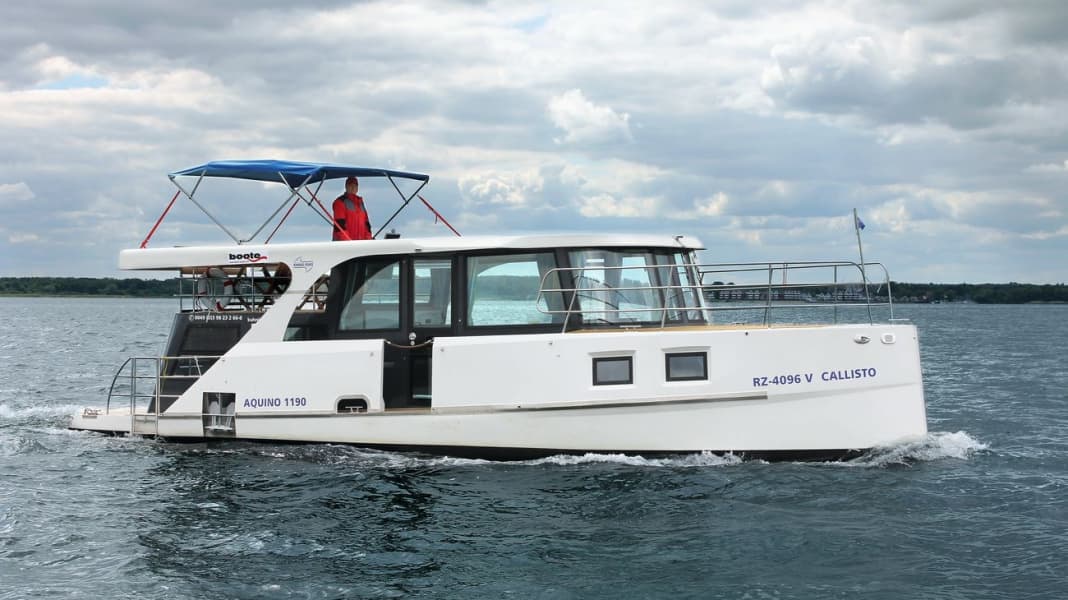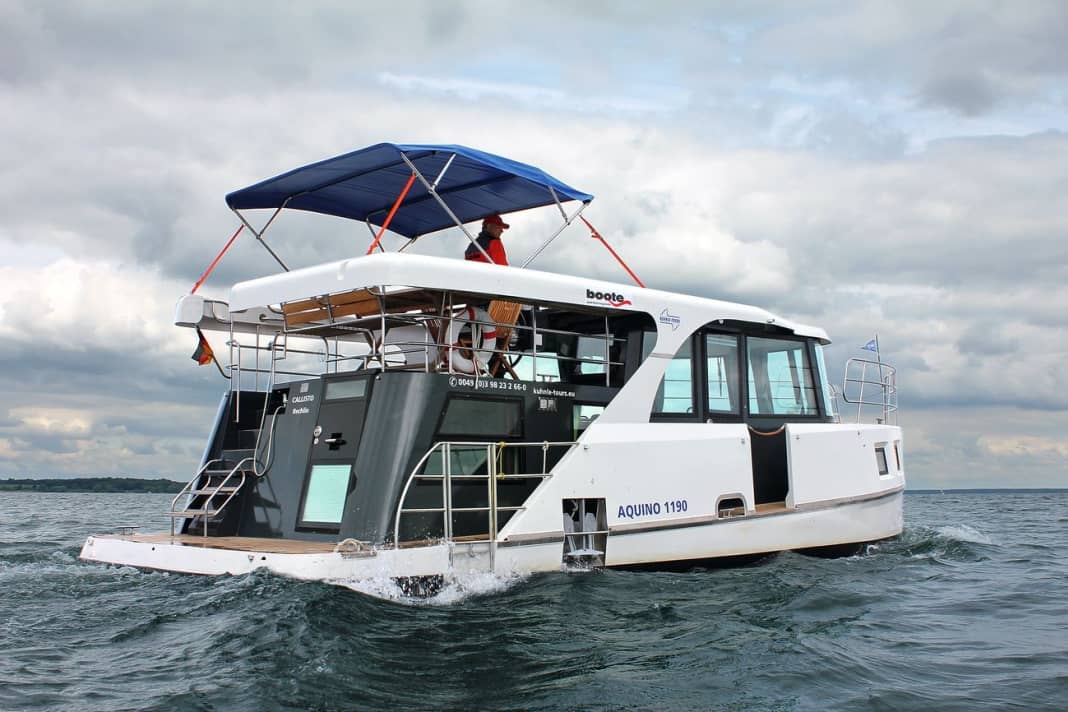
Anyone who has ever been in contact with the cormorants of theKuhnle shipyard If you've ever been on the road, you know that these "things" are practically divided up and almost indestructible. Ideal, if it weren't for their appearance! Names such as "travelling iron" or "steel horse" are not uncommon.
However, Harald Kunhle is convinced that the lines of these "boats with character" will still be timelessly elegant in 20 to 30 years' time
Nevertheless, the shipyard took up the wish of some customers to build a modern steel boat. The result is theAquino 1190which is chartered by Kuhnle, but is also offered as an owner's version, just like the entire Kormoran series.






We drove our test boat on theMüritzThe starting point was the Kunhle charter base in Rechlin. As soon as you cast off, you realise that they want to make things as easy as possible for the skippers, as the boat is equipped with a joystick system.
It makes donning and doffing child's play
You have toStick Simply push the stick in the desired direction and the Aquino moves precisely and accurately along the chosen route. The fuselage can even turn on its own axis effortlessly by turning the stick to the left or right. This is made possible by theHydraulic system the Aquino. It consists of a hydraulic pump that is flange-mounted to the engine instead of a gearbox. This in turn drives the hydraulic motors of the bow thruster, stern thruster and propeller shaft.
If you push the lever forwards, the Aquino initially behaves like a boat with a reversing gear. The higher the speed, the faster it travels. However, the point around 1750 rpm is striking, because from here the speed (11.5 km/h) barely increases (around 0.3 km/h) up to the maximum speed of 2850 rpm.
The boat does not reach the theoretical hull speed of around 15 km/h. A sign that the fine tuning between diesel, hydraulics and propeller is not yet right. Our test combination therefore runs economically at 1750 rpm and achieves a respectable 750 km with one tank of fuel (550 litres) minus 15% reserve. If the engine speed is controlled a little, ranges in the four-digit kilometre range are quickly achieved.
The boat is steered using boat-shaped steering wheels, which are turned smoothly at both driving positions. In order to maintain a straight course, the motto is: let it level out and only counter-steer a little. The rudder position indicator proves to be an advantage here, allowing you to quickly find the centre position again after a bend; on the subsequent straight-ahead course, you should only swing very slightly around this point so as not to drive in serpentine lines. If you put the rudder completely athwartships, you will not be surprised - the test boat only leans slightly on the outside of the bend and travels comfortably around the bend.
The driver's seat below deck is a free-standing, raised sports seat with armrests. Shortcoming: If you sit directly in front of the steering wheel, there is very little legroom as it cannot be pushed back far enough (your foot touches the saloon bench). Otherwise, the driving position is kept very sober and is equipped with everything you need apart from the compass.
The passengers are well protected behind the dark windows; the shipyard has installed two windscreen wipers for rainy weather, although the wiper panels are only tiny. Two staircases with railings lead to the upper deck to the outside driving position, which are well dimensioned for safe ascent and descent. It is easier to get on and off from the upper deck than from the lower deck. Most of the activities take place up here in the fresh air, as the lower deck has an integrated
The designer only designed one platform, which is open aft. A bathing ladder, operated via a rope, is integrated into the starboard railing. Right next to it and quite unusual: an anchor
anchor housed in the side wall. This is intended as a second anchor, while the main anchor with electric winch is located at the bow.
Below deck, there are three berths in the forward cabin and two in the aft cabin. Exemplary: all have a special topper (Gisatex) under the normal mattress, which ensures good ventilation. The seating area in the saloon can also be converted into an emergency bed. However, more than five people are not recommended for longer periods. The optimum occupancy is four crew members.
The galley with three-burner gas hob, oven, large sink and fridge is located in the saloon. Two bathrooms, which are fully equipped with WC (electric), shower and washbasin, offer additional comfort.
The drive unit can be easily accessed for visual inspection via a small hatch in the saloon floor; for service work, the technician removes a large hatch and can work without restriction.
The shipyard has carried out the installations throughout the boat properly. The unrounded corners of the fixtures and fittings are a nuisance, as they are easy to cut. In terms of workmanship, the picture is passable, but the unsightly orange peel on the painted surfaces is particularly noticeable. Good: the weld seams.
Data sheet: Aquino 1190
Shipyard: Kuhnle shipyard
Type designation: Aquino 1190
CE category: C - Coastal waters
Material of hull and deck: Steel
Length: 11,90 m
Width: 3,90 m
Displacement: 15,50 t
Price: 380.205,00 €

